Suppose you’re looking to give your indoors some AESTHETIC taste and appeal. You’re right about choosing to grow an indoor moss garden. If you haven’t done it before, you’re in luck.
As a BONUS, it’s a fun activity you can do with children. In the end, you’ll question yourself, ‘how much moss is too much moss?’.
With our experience and insights, growing moss indoors is an EASY JOB! At Astergardening, you learn how to build a LUSCIOUS moss garden, that too FROM SCRATCH. With this guide, you’ll become a MASTER at growing moss.
We tell you how to grow moss indoors, and your indoor moss garden will be absolutely STUNNING!

What is Moss? When to Plant Moss Indoors?
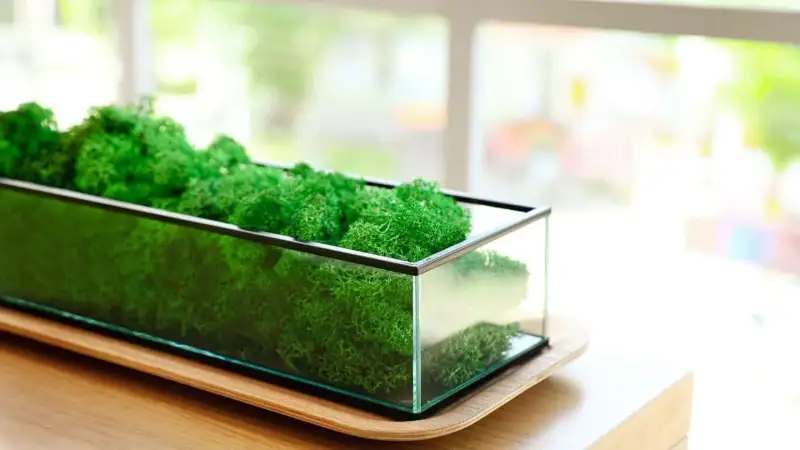
Just something to remember, and it sounds impressive! Moss is a non-flowering plant that doesn’t have real roots. They do, however, have stems and leaves and produce spores. In technical language, they classify as Bryophyta in the plant kingdom.
Here’s another exciting thing for you. Moss has been around the world for 450 million years! There are around 15,000 – 25,000 moss species, each a little different from the others.
It’s an attractive plant to have in your collection of indoor gardens. This green carpet is quickly grown indoors and gives a unique look. The plant grows in a shady and humid environment, so it makes sense to grow moss indoors.
Tools for Your Indoor Moss Garden

You must have the right tools to enjoy growing your moss garden. Growing moss is slightly different than other plants. That’s why you need to know what tools you will need for this.
1. Container
To grow moss indoors, you’ll have to grow it in a container. Now, you have many options for what containers to choose from. Opt for either a glass or plastic container. Both work fine, and there isn’t a specific preference.
You can make a container out of wood, which looks very aesthetic. But it’s better to focus on convenience.
Get a clear glass container if you want an aesthetic look for your indoor moss. With this, your garden is visible from the outside. It’s REFRESHING.
2. Pincer
You need some essential tweezers when arranging your moss inside your container. Suppose your container has a narrow opening, so you’ll need a pincer to place the moss properly.
3. Gravel
When making the base of your moss garden, you’ll have to layer it with pebbles. You can also use small pebbles as a base layer for your garden.
4. Pine needles, bark or potting soil
Moss mainly grows widely in forests. Although not demanding where it grows, it requires a certain kind of environment. You could use rotten tree bark or pine needles for your moss to replicate that environment.
This isn’t a hard and fast rule; you can also use potting soil, which works fine.
5. Soil pH test strips
Moss grows in slightly acidic soils. Get yourself Soil pH test strips to ensure the soil is just the right environment.
6. Spray bottle
One word, moisture. Your moss garden only succeed if it is provided with adequate moisture. You do it conveniently with a spray bottle.
Advantages of Growing Moss Indoors

A moss garden will brighten your room and give it a different feel. Alongside this, they have other benefits too.
Bio-Air filtration
Your moss garden absorbs air pollutants and turns them into water and carbon dioxide. It’s a natural air purifier. It’s good to know that your plant also makes the air HEALTHY for you.
Aesthetically Pleasing
When done right, it looks absolutely STUNNING! You play with the ideas of what you can do with moss plants. Make a wooden tray, grow them on the wall, on a stone, or have them grow in glass containers. Only moss can pull up so many looks.
Energy Saving
Moss acts as an excellent insulator if you make a moss wall. It allows for walls to retain their temperature and insulates the indoors.
How to Grow Moss Indoors?
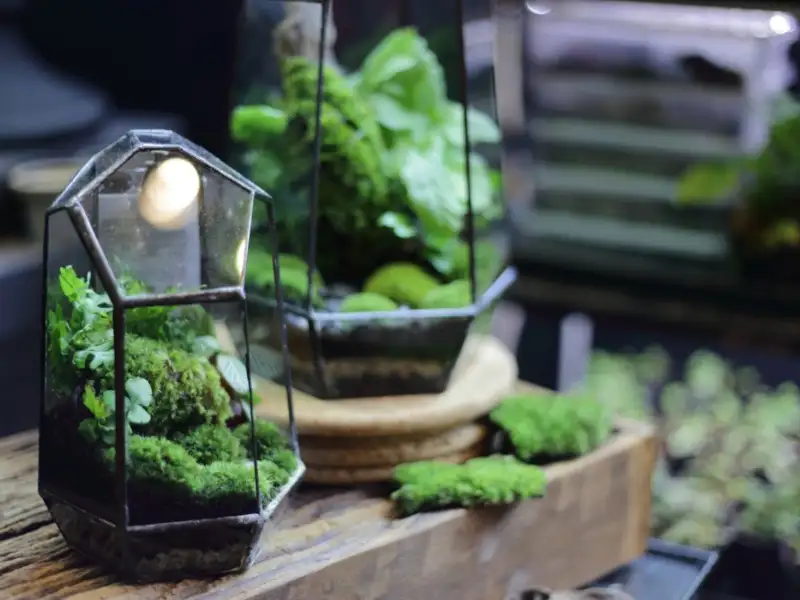
Lets get to it! We’ll take you on a step wise guide on moss growing.
1. Find Moss
Moss grows mainly alongside wetlands and forest areas. You find them on sidewalk cracks as well. So if you want to go out on a SAVENGER HUNT to collect moss, you find it in many natural places.
Your local nursery might have different varieties as well.
2. Clean Your Moss
Once you’ve gotten your moss, get a container and fill it with distilled or purified water. Make sure that you’re not using tap water. Moss is sensitive to any chemicals which might harm it.
This is because you want to remove debris or critters. Let the moss thoroughly soak in that water for about half an hour. You repeat this cycle once to ensure that you’ve thoroughly cleaned it.
3. Find A Container
Wooden trays are aesthetic containers. Terrariums are also a popular option in moss gardening. So you have a variety of containers to choose from.
4. Prepare Your Container
After getting your moss, you need to prepare an ecosystem for your moss. Since they don’t have a root system, you’ll have to create an environment the moss requires.
Make a drainage layer. Gravel works or even pebbles. Make sure it should be at least one pebble deep when you’re layering out the drainage layer. This layer helps perpetuate the water filtration cycle. It also prevents the substrate from getting too soggy from the water.
You’ll need a base for the moss to stick to, what we call the substrate. Moss likes compact soil. You can collect dirt from a fallen tree.
Or use any regular garden soil. You bake the soil in the oven to eliminate any infectant that might harm your moss and affect its growth.
Gardening soil works just fine, as moss is very adaptive and grows well.
Once done with your base layer, use your spray bottle and mist it slightly. There’s no need to drain the base.
HACK: Scatter tiny pieces or even powdered charcoal over your substrate. This helps your soil retain its acidity levels, and moss thrives in such conditions.
5. Decorate
Now you have to get creative with what you want to do with your moss garden. Just adding simple elements light a piece of wood or a large stone really sets the mood.
Which Moss Varieties Can Be Grow Indoors?
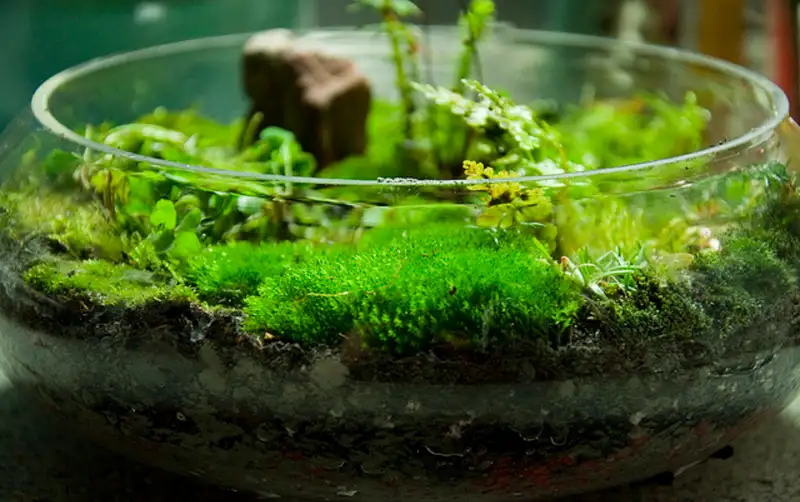
Almost all varieties of moss grow indoors. But it’s better to understand which ones are notably easier. Sphagnum moss and Hypnaceae are two types of moss that grow well indoors.
You’ll need to be an expert to identify which one is which. But if you’re getting them from a nursery, get this specific kind.
What are The Common Problems with Growing Moss?
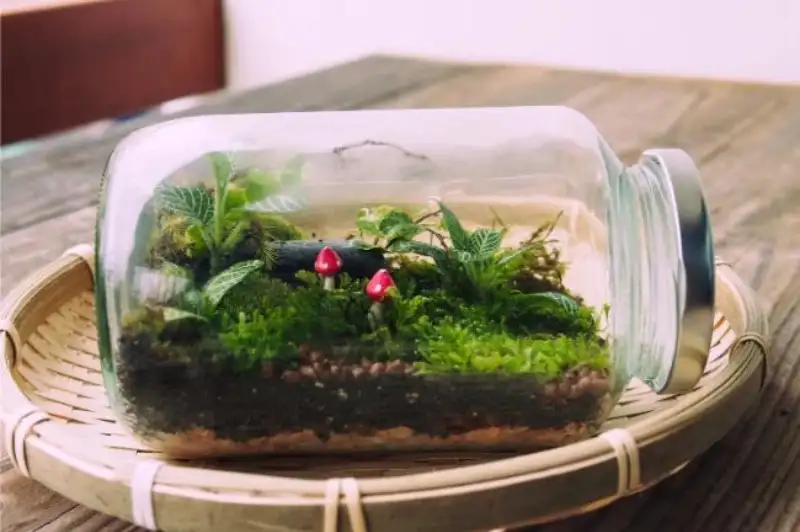
When growing moss indoors, there are a few challenges you should be aware of, though.
Pruning
Pruning is a way to promote healthy regrowth. One common problem you might face is that your moss starts to overgrow (meaning happily). It would be best if you considered pruning. Cut off any growth which doesn’t sit right with the setting.
Mold
One common problem is the creation of molds. Mold grows in high humidity. To prevent mold growth, make sure that there is some air circulation in the container.
The formula here is not too less nor too much. Just enough to let the moss retain its moisture levels.
If you see a mold develop, don’t panic. Just take some tweezers and remove that part of the mold.
How to Care Moss Plant Indoors?

Now that you’re done with placing your moss in a container. You have to take care of specific do’s and don’ts.
Watering
Moss is naturally occurring. Unlike other plant species, it doesn’t appreciate when misted with tap water. Growing moss indoors, you should be very particular about the water you spray it with.
Make sure that you only use distilled water when it comes to moss.
Another thing you must be careful with is that moss doesn’t appreciate any excess water. This is the reason we made the container in a way as to recycle the same water that we spray.
Moss functions differently. Because of the absence of roots, the moss takes its water intake from the air. This is why you need to mist moss and not water it.
So make sure to mist regularly, that too with distilled water.
Ensure you cover the lid immediately after misting the plant to retain its moisture. If you see it turning brown, increase the frequency of misting. If the growth remains stunted even after a month, you’ve been giving it too much water.
Sunlight
When you’re growing moss, it doesn’t appreciate direct sunlight. If you ever notice your moss turn brown, it’s probably because of too much sunlight. The BEST WAT is to place it in indirect sunlight, where it doesn’t get too much for the plant.
What Types of Moss are Good for Terrariums?
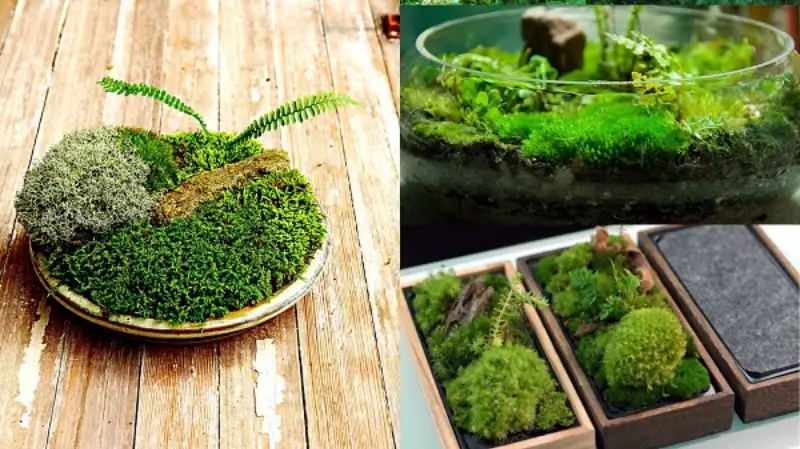
Planting moss in a terrarium is a typical thing you’ll find in indoor moss gardens. Closed terrariums offer to make an ecosystem for the moss. This helps it with recycling water and pouring back onto it like rain.
Can you BELIEVE that? It’s like you’re making YOUR OWN ECOSYSTEM in a jar!
If you’re looking to cultivate moss in a terrarium, there are some specific types you should look out for.
- Pleurocarpous (Also known as sheet moss or carpet moss)
- Acrocarpous (Also known as clumping moss)
Of course, other types of moss grow as well, but these will be an excellent fit for your terrariums.
FAQs about How To Grow Moss Indoors
1. Can you grow moss indoors without soil?
This mostly depends on the species that you’re trying to plant. But you can grow moss without soil. As a very adaptive species, moss has learned to grow in different environments. It’s primarily found in places where there isn’t any soil. That’s why it prefers to grow on a base like a tree bark and pine needles.
2. Does moss indoors attract bugs?
Moss doesn’t attract any bugs. Insects are primarily attracted to the soil in plants which this doesn’t have. If you’re thinking of establishing preserved moss walls, they don’t have any soil, thus no bugs.
3. How long does moss last indoors?
Your moss is as good as the care you give it. Moss could last years if you treat it right.
4. Can moss grow with LED lights?
Yes, as a subsidiary to sunlight, you can grow your moss in LED lights. Just make sure to put them on a cycle, with 10 hours on time and 14 hours off time.
What’s Next
Once you get the hang of this plant and master moss growth, you’ll want to dive into more species of this ANCIENT plant. Here are some which might interest you:
- Spanish moss
- reindeer moss
- mood moss
- peat moss
- fern moss
- cushion moss
We have some great ideas for you on our website, where you get creative. From differently shaped rocks to wood pieces, there are many things to make this a gardening style you would enjoy the most.
We’re certain you had a great time reading this article and will have an even better time growing moss now. It’s going to be a fun activity when you have someone to discuss it with as well.
Share this article with your friends, and go on this journey to make a small ecosystem together.
